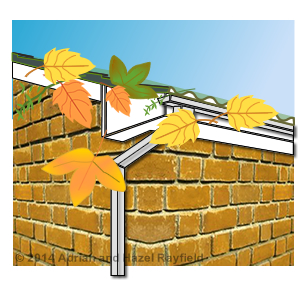Painting, decorating and home improvement tips blog
Getting your home ready for winter
Posted by Adrian
December 8th, 2014
Getting your home ready for winter
After such a mild autumn we could be in for a harsh winter, so being prepared in advance is vital. Doing essential jobs before the winter sets in could prevent any issues during the winter months.
If you own property and rent it out it is advisable to get your rented property checked over as well, prevention is better than cure as they say.

What to check and fix before the winter
Things such as heating, boilers and radiators are the most obvious things to check and service before the winter, but less thought about things such as gutters and drains also need to be looked at.
Boiler, radiators and pipes
Getting your boiler serviced (by a qualified engineer) could not only prevent a break down when you need it most, but if it runs efficiently it could also save money on your gas bill.
Radiators should be bled to ensure no air is in the radiators and they can supply you with efficient heat, you can tell if your radiator needs bleeding as they will have a cold spot at the top, if it is cold at the bottom, this indicates a buildup of sludge and rust, this should be flushed out to get the most from your radiators this winter.
Pipes, these should be lagged including any pipes outside such as in outbuildings or garden taps. If pipes are not lagged and they freeze, they could burst and cause flooding.
You can read about how to avoid freezing pipes on our Rayfields site.
If you are going away, or you have a empty rented property, it is a good idea to leave the heating on low just to prevent pipes from freezing. Now is also a good time to know where stop cocks and valves are, just in case of an emergency.

Roofs, gutters and drains
Roofs take a battering in the winter with strong winds, rain, sleet and snow. It is a good idea to give it a visual inspection from the ground. If you have access to a ladder you could look at it closer but don’t get on the roof without the necessary safety equipment. Look for missing or broken tiles including ridge tiles, look at the state of the chimney if you have one. If anything needs repairing get it done sooner than later as roofers can get busy.
Gutters get full of falling leaves and can block the downpipes, clear guttering out and fit a downpipe leaf guard to stop debris falling down the downpipe. Also check where the downpipe goes, is it an open drain, does this flow well or is it blocked? A blocked drain could cause damp to your property.
You can read a post I did about cleaning out your gutters on our Rayfields site.

Insulation, doors, windows
Does your loft have enough insulation in it? Are any pipes and hot water tank properly lagged all these should be looked at for both rented and private owned properties. Are you walls cavity insulated or can they be, you may even be able to have it installed for free. So it is worth a little time checking.
Do your windows and doors fit and close as they should? If you have draughts you could fit draughts excluders around windows and doors. If your windows don’t shut well because the handle is broken, get it fixed, reducing draughts will help keep the heat in and cold out, thus saving on heating bills.

Tags: Bleed, Boiler, Doors, Drains, Freeze, Guttering, gutters, Home, House, Insulation, Pipes, Property, Radiators, Rented, Roof, Windows
Posted in Decorating Tips | No Comments »
How to fit new guttering
Posted by Adrian
August 25th, 2012

How to put up new guttering
With the end of the summer quickly approaching now is a good time to start thinking about jobs that need doing before the winter sets in. One job that may need doing is guttering, you may need to fix a leaking joint or replace a length of damaged downpipe. Whatever the job now is a good time to do it.
Choosing your guttering
If you are having new guttering you need to decide on which type be it round or square and the colour you prefer, black, brown or white. Then measure up allowing for any cutting that maybe required. Make sure you get enough brackets for the gutter and downpipes. It is advised to have a bracket every metre, this will give the gutter enough support when you get heavy snow sitting in it.
Buying the guttering
Once you have decided on your gutter and measured up it is now time to buy the guttering, ensure you get any outlets either running outlet or stopend outlet, stopends, any angled gutter, a shoe/boot for the end of the downpipe, downpipe and clips, and any union brackets.
Fixing the guttering
You may find it easier with two people to do this job, so now the time to call on a mate to help, but it can be done by just one person for those people with no mates!
Decide on where the outlet is going to be, you may not have a choice as the downpipe may go into a drain or you may want it to go into a water butt. The important thing to remember is the outlet has to be the lowest point for the water to run out of it. One additional tool you will need for this job is some string, this could be a chalk line or string you found in your wife’s craft draw! it doesn’t matter as long as it is long enough to span the length of where your fixing the guttering, which may be the entire width of the house, so a good 5 or 6 metres will be needed.
Now you know where the outlet is going, you can start to fix the guttering, take a bracket and place it against the fascia board and close to the roof tiles , mark the holes, drill and screw the first bracket to the fascia. Now go to the other end of the fascia, if the outlet is going to be at one end, come in about a metre from the end of the fascia and fix another bracket about an inch and a half down from the roof tiles. Now take your string and tie it between the two brackets pulling it tight to give it tension, this will give you a nice gentle fall toward the outlet. Now simply take a bracket measure about a metre from the first one, slide the bracket up to the string line, drill and screw, continue doing this until you get all the way along, you may have to decrease the gap to get brackets around a metre apart, don’t increase by much as the weight of the next snow could pull your gutter down.
If you have your outlet in the middle of the fascia, the same principle applies but work from one side then the other toward the middle, or wherever the outlet is.
Once all the brackets are up you can work out where the stopend outlet needs to be fixed, remember this still needs to continue to have a fall on it from the the last bracket you fitted.
Putting it all together
Next you need to measure and cut the gutter to fit between any union brackets or stopends, once all clipped into place you need to fit the downpipe, cut and fit the the downpipe and angles together to get the downpipe to where you want it to go, simply secure the downpipe to the wall with the downpipe brackets. Ideally your rain water would go into a water butt, this can easily be done by using a water butt connector, this allows the water butt to be filled from the downpipe and when it’s full will continue down the downpipe to a drain, so not overflowing.
Tags: Downpipe, Gutter, Guttering, Running Outlet, Stopend, Stopend Outlet, Union Bracket
Posted in Decorating Tips | No Comments »
